October–my favorite month–honors some of my favorite saints. St Thérèse (Oct 1), St Francis (Oct 4), and St Teresa (Oct 15) are each associated with their hometowns: Lisieux, Assisi, and Avila. Let’s explore St Teresa’s Avila in Spain.
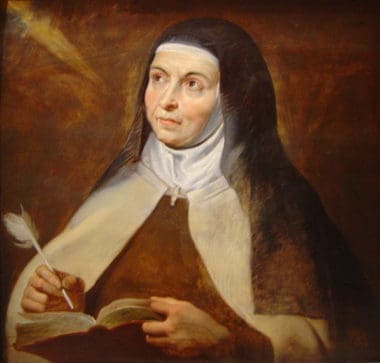 Did you know that St Thérèse of Lisieux and Mother Teresa were named after St Teresa of Avila? I love St Teresa because she was a feisty Spaniard who was as holy as she was straightforward, and that reminds this feisty Mexican-American that there’s hope! Once, when she was complaining to God about the hostility she encountered, He said, “Teresa, that is how I treat my friends.” She replied, “No wonder you have so few!” She also said, “May God protect me from gloomy saints,” “Be gentle to all and stern with yourself,” and “There are more tears shed over answered prayers than over unanswered prayers.” Then, of course, there’s her famous prayer:
Did you know that St Thérèse of Lisieux and Mother Teresa were named after St Teresa of Avila? I love St Teresa because she was a feisty Spaniard who was as holy as she was straightforward, and that reminds this feisty Mexican-American that there’s hope! Once, when she was complaining to God about the hostility she encountered, He said, “Teresa, that is how I treat my friends.” She replied, “No wonder you have so few!” She also said, “May God protect me from gloomy saints,” “Be gentle to all and stern with yourself,” and “There are more tears shed over answered prayers than over unanswered prayers.” Then, of course, there’s her famous prayer:
 Let nothing disturb you,
Let nothing disturb you,
Let nothing frighten you,
God does not change,
Everything passes,
Patience obtains all things.
Whoever has God lacks nothing;
God alone suffices.
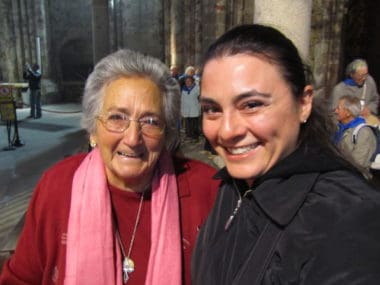 In October 2010, my husband and I were blessed to visit the remarkable city of Avila on October 15th, the Feast of St Teresa. Not only did I drag him to all of the Catholic sites, I made him process in a parade with me in honor of St Teresa (he loved it!)! (Check out the video!). I met an amazing woman who reminded me of my own abuelita (grandmother), and who made me feel welcomed in this foreign city.
In October 2010, my husband and I were blessed to visit the remarkable city of Avila on October 15th, the Feast of St Teresa. Not only did I drag him to all of the Catholic sites, I made him process in a parade with me in honor of St Teresa (he loved it!)! (Check out the video!). I met an amazing woman who reminded me of my own abuelita (grandmother), and who made me feel welcomed in this foreign city.
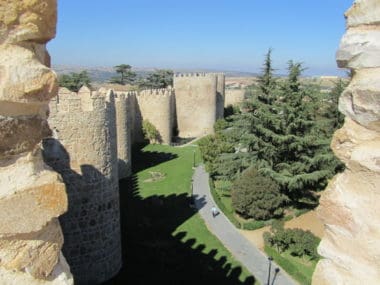 The first thing you notice as you near Avila are the huge 11th and 12th-century walls that protect the city. Walking these walls is a fun way to explore Avila from up high. St Teresa, who was born March 28, 1515, and died October 4, 1582, would have known these walls. She might have even walked them!
The first thing you notice as you near Avila are the huge 11th and 12th-century walls that protect the city. Walking these walls is a fun way to explore Avila from up high. St Teresa, who was born March 28, 1515, and died October 4, 1582, would have known these walls. She might have even walked them!
We started the feast day off with Mass in the 12th century Avila Cathedral, 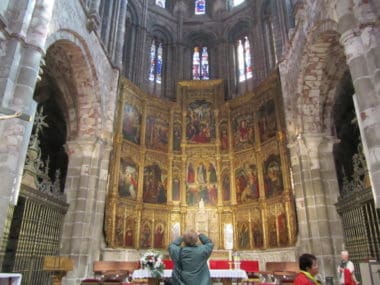 dedicated to San Salvador (Holy Savior). The cathedral is built into the walls and looks like a fortress. It’s Romanesque and Gothic styles show how tastes changed over the many years it took to build. I loved the huge, gold retablo-like piece behind the altar. There’s a LOT of gold in Spanish churches, and as a woman of Mexican heritage, it always makes me laugh and think, “So that’s what the Spaniards did with all the Aztec gold!” Ha.
dedicated to San Salvador (Holy Savior). The cathedral is built into the walls and looks like a fortress. It’s Romanesque and Gothic styles show how tastes changed over the many years it took to build. I loved the huge, gold retablo-like piece behind the altar. There’s a LOT of gold in Spanish churches, and as a woman of Mexican heritage, it always makes me laugh and think, “So that’s what the Spaniards did with all the Aztec gold!” Ha.
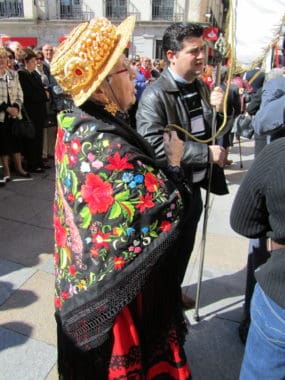 After the Mass, we processed through Avila with statues of St Teresa and Our Lady.
After the Mass, we processed through Avila with statues of St Teresa and Our Lady.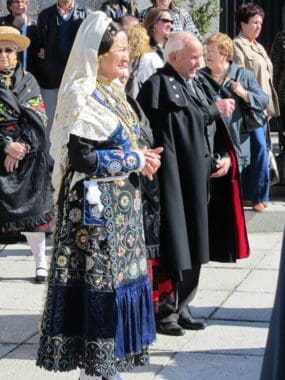 We saw the traditional mantillas and combs. Many of the women were dressed in the traditional clothing of Avila–beautifully embroidered and fringed shawls, straw hats, colorful skirts adorned with black lace, white socks with pom poms, and Mary Janes. I wanted to buy this outfit before I left, but the store that sold them was closed on our last day. Boo.
We saw the traditional mantillas and combs. Many of the women were dressed in the traditional clothing of Avila–beautifully embroidered and fringed shawls, straw hats, colorful skirts adorned with black lace, white socks with pom poms, and Mary Janes. I wanted to buy this outfit before I left, but the store that sold them was closed on our last day. Boo.
Our procession brought us to the 17th-century Convent of St Teresa, built after St Teresa’s canonization over her childhood home. The convent houses some of St Teresa’s relics–a finger from her right hand, the sole of one of her sandals, her rosary beads and a cord with which she used to flagellate herself. I loved the statue in the small garden where she played as a child.
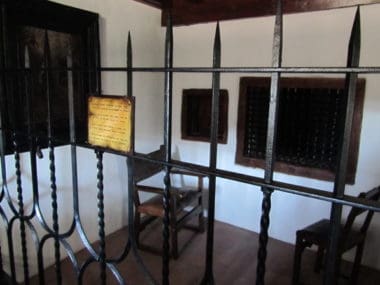 Outside the walls, we found the Monasterio de la Encarnación (Monastery of the Incarnation), where St Teresa first entered Carmel on November 2, 1535. Back then, the convent was wealthy and its rules were relaxed. But during the 30 years St Teresa lived here, she whipped them into shape. Here, she received visits from St John of the Cross, and in a small room you can visit, she even received a visit from Jesus. (Things like this always thrill me until I remember that I can visit Jesus in the tabernacle every day.)
Outside the walls, we found the Monasterio de la Encarnación (Monastery of the Incarnation), where St Teresa first entered Carmel on November 2, 1535. Back then, the convent was wealthy and its rules were relaxed. But during the 30 years St Teresa lived here, she whipped them into shape. Here, she received visits from St John of the Cross, and in a small room you can visit, she even received a visit from Jesus. (Things like this always thrill me until I remember that I can visit Jesus in the tabernacle every day.)
The Convento de San José (Convent of St Joseph) is the first monastery of Discalced Carmelites founded by St Teresa, and that’s here in Avila, too.
 The food in Avila is amazing. Our favorites were the Jamón Iberico, Manchego cheese, patatas bravas, and croquetas. YUM! I did have to try the local delicacy–Yemas de Santa Teresa. They’re little sugar balls made with egg yolks. I didn’t like them (sorry, St Teresa!).
The food in Avila is amazing. Our favorites were the Jamón Iberico, Manchego cheese, patatas bravas, and croquetas. YUM! I did have to try the local delicacy–Yemas de Santa Teresa. They’re little sugar balls made with egg yolks. I didn’t like them (sorry, St Teresa!).
As I write this and pour over the hundreds of photos from our trip, I think how much I’d love to return to this quaint little city, imbued with the spirit of this fantastic saint. Maybe I’ll read some of her books to remind me. Maybe in a year or two, we’ll return. Of all the incredible cities Spain has to offer, Avila will always remain one of my favorites.
+
Art: Personal photos and video courtesy of Diana von Glahn. Teresa of Avila, Peter Paul Rubens, 1615, photographed by David Monniaux, 2005 own work; Yemas de Santa Teresa (Egg yolks of Saint Teresa), photographed by Tamorlan, 2009 own work; both CCA-SA 3.0 Unported; both Wikimedia Commons.





